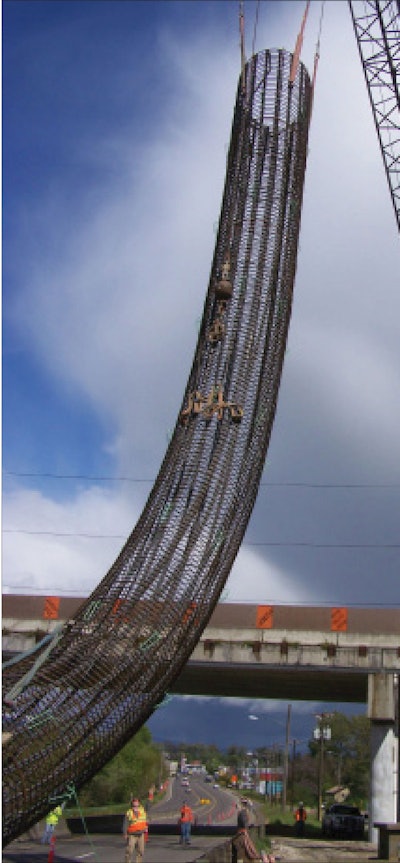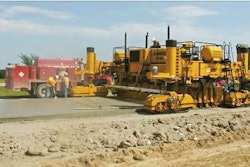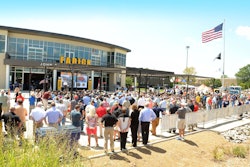All Together Now
 This rendering shows how the new Willamette River Bridge will look upon completion.
This rendering shows how the new Willamette River Bridge will look upon completion.By Tina Grady Barbaccia
A bridge project that started out under intense scrutiny in an environmentally- sensitive area is now being cheered and even has the locals putting their own touch on the bridge.
The Oregon Department of Transportation (ODOT) credits this to using the construction manager/general contractor (CM/GC) approach — where the contractor works with an agency from the beginning of the project instead of after a design has already been developed.
 Looking north at I-5, pictured (from left to right) are the work bridge, the decommissioned bridge and the new, temporary detour structure. The decommissioned structure in the photo has since been demolished.
Looking north at I-5, pictured (from left to right) are the work bridge, the decommissioned bridge and the new, temporary detour structure. The decommissioned structure in the photo has since been demolished.The Interstate 5 deck arch type bridge over the Willamette River is a $201-million replacement project located at milepost 192.7, where it crosses the river between the cities of Eugene and Springfield. It was funded by the 2003 Oregon Transportation Investment Act and the federal Safe, Accountable, Flexible, Efficient Transportation Equity Act: A Legacy for Users (SAFETEA-LU) program.
“The biggest advantage [to using a CM/GC approach] is the flexibility to balance the public’s expectations while maintaining the level of public participation the owner wants to provide,” explains Kevin Parrish, project manager with Springfield, Ore.,-based Hamilton Construction, which is the construction manager/general contractor on the bridge project.
Traditionally, an agency would determine a project’s scope, the project design, and the schedule. Then, the amount of money to be spent on a project was determined. “A designer would work up the project, put it out to bid, and the contractor with the lowest price would get the project,” Parrish explains. “Then the public would see it.” With the CM/GC approach, the contractor is involved in the entire process. This approach isn’t new. It’s common in the private sector, but for DOTs, it’s considered to be an innovative approach.
 A steel rebar reinforcement cage for bent 6 will be placed into the bent to support and reinforce the structure. The orange signs visible on the bridge in the background are part of the project’s “gawker screen,” a barrier used to prevent drivers from staring at the construction site and keep focused on the road.
A steel rebar reinforcement cage for bent 6 will be placed into the bent to support and reinforce the structure. The orange signs visible on the bridge in the background are part of the project’s “gawker screen,” a barrier used to prevent drivers from staring at the construction site and keep focused on the road.“We hire the contractor at the start of the design,” explains Dick Upton, major projects unit manager for ODOT and project manager for the I-5 bridge project. “As construction manager, he [the contractor] and his team work with us through design, fundamentally giving constructability reviews and more or less guiding our construction approach to the way he would prefer to approach the job.”
This is a pilot program for ODOT, and one of the first times this approach has ever been used on horizontal construction. “Before we launched down this path, we did a scan of agencies doing it,” he says. Only Arizona and Utah were currently using the CM/GC approach. “Now Nevada is calling and asking questions [about our approach] too,” Upton says.
Vocal locals
Involving the public from the start was a must.
“In Eugene, members of the community take a high interest in publicly-funded projects,” Parrish says. “The locals are very vocal.”
ODOT is using the high level of interest in the project to help shape the design of the bridge and the surrounding natural area. “There have been some projects that haven’t gone over as well, and ODOT has learned from that,” Parrish says. “ODOT wants to serve the public good. A project that could have generated a lot of negative publicity is now providing eagerly anticipated improvements and enhancements to the surrounding area.”
The bridge project crosses directly over the Whilamut Natural Area, which includes two well-used and very popular bike systems that lead up to the bridge but were not connected. Replacement of the bridge affects usage of the trails.
The CM/GC approach enabled the public to be part of the entire replacement process, and to be sensitive to the needs of the community with how the bridge replacement would affect the bike trail usage. It has helped to make a delicate situation quite manageable, by further keeping the community closely involved in the bridge replacement project. Bridge designers were brought in and the two paths will now be connected, a much-anticipated improvement for the area’s large cycling community. For the community, these improvements have become as important to the locals as the bridge project itself — almost as if it were a bike trail project with a minor bridge component.
“Instead of coming in with plans already in place, ODOT asked us to involve the community,” Parrish notes, adding that it has worked well. “The communities here have a love-hate relationship with construction. This really shows up in our citizen groups. The most unique feature of advancing this project is the citizen group ODOT put together to help guide the bridge design development and contribute and comment on the aesthetics of the structure.”
The bridge is in a prominent place in the community, so the aesthetics are important. In addition to serving as the gateway to Eugene-Springfield, the bridge bisects one of the largest parks in the area. Artistic features on and around the bridge are being imprinted into the concrete by a local design team.
In the beginning
In 2001, ODOT began inspecting bridges for cracks. Bridge inspection reports in 2002 showed shear cracks growing quicker than expected throughout the reinforced concrete beams supporting the original bridge deck. This raised concerns that the bridge would not stand up to traffic unless truck weight restrictions were imposed, or a detour route could be provided. Recognizing the lengthy public process required to design and permit the permanent replacement structure, ODOT designed a detour bridge to carry I-5 traffic until the new structure was in place.
The detour bridge was designed, permitted, and advertised under an “A+B” contract method that considered the construction schedule as well as the contract amount to determine the “best value” for award. Hamilton Construction won the award in September 2003, and opened the bridge to traffic less than a year later.
The original bridge — the decommissioned bridge — couldn’t support the traffic it was carrying and needed to be taken out of service. ODOT immediately realized there was a problem: they either needed to build a replacement bridge or they would have to detour trucks off Interstate 5 and send them right through downtown Eugene on old Highway 99. “ODOT raced to quickly design a replacement bridge,” Parrish says. “It had to come up with the simplest bridge to design and construct to get it done quickly. There was not a lot of time for public input, and the only access for construction to it was through the Alton Baker Park natural area.”
Having the public on its side has made a big difference, Parrish notes, especially when working to obtain a permit. This can often be a long, tedious process, but in an environmentally-sensitive area it’s even more of a slippery slope. To add more traction to this slope, ODOT developed its programmatic permitting process to speed environmental approvals. ODOT met with all the regulatory agencies that are involved in the bridge rebuilding process and proposed that they jointly develop a set of standards that — if complied with — would enable the agency to secure a permit in a timely manner. “With these permits, whoever is submitting for them must have definitive information on how a project will be built,” Parrish says. “The whole idea is to minimize the impact by putting as little material in the river as possible. If the project was designed as a design-bid-build project, you’d either have to pay a contractor to comply with the designer’s assumed construction methods, or delay the project until the permit could be modified to comply with the contractor’s construction methods.”
Hamilton Construction helped ODOT and their designer, OBEC Consulting Engineers, put together a permit application denoting exactly how the bridge was going to be built, including temporary work systems and contracts. “With the decommissioned bridge being a box girder, we have to collect 100 percent of the rubble and debris on our containment,” Parrish says. “Consequently, we developed a demolition plan that utilizes a containment platform that allows us to run equipment, and to collect and support all the concrete rubble during the demolition process. But all of this planning was done very early in the process to find the best balance between our preferred construction methods and the requirements of the regulatory agencies. This should allow us to deal with fewer variances.”
Using a CM/GC approach enables construction of temporary work, such as site preparation, access roads, and demolition work, to start before completion of the final bridge design. “This was done as part of the process to come up with pricing,” Parrish says. “Early work packages enable us to identify portions of a project that we can isolate out as a unique section to determine the scope clearly and definitively. The CM/GC delivery method allows us to start work on these early work packages right away — and to work on them concurrently instead of consecutively.”
In good times and in bad
However, with all good things oftentimes challenges do arise. Despite the advantages, some of the details and other minutiae proved to be challenging.
“We have struggled with the intricacies of the contract,” Parrish says. “Agencies aren’t used to seeing indirect costs.”
With the CM/GC approach, all cost negotiations are done on an open book basis. “That means once we start negotiations or are working through estimates, we show material quotes, subcontractor quotes, our production rates, etcetera,” Parrish continues. “Normally, an agency never sees this. It just sees the bid price, which has costs, markups, contingencies, etcetera. Agencies are seeing an incredible amount of details. If they haven’t worked as a contract, they don’t know how estimates are put together.”
Parrish advises that agencies considering the CM/GC approach be very clear with what they want to see and how projects are broken down. “There are general conditions components — onsite trailers, risks, etcetera,” Parrish says.
He adds that the real message that should go out is that it’s important for agencies to understand components of a contractor’s price – i.e. what goes into an estimate. “These components are cost of work, labor, material and equipment costs, general conditions cost, risk cost, and profile or overhead for the contractor,” Parrish points out. “The contractor’s profits are what pay the taxes to support the agency. The CM/GC is where our profit is to reside.” v
Oil Change
Kevin Parrish, project manager with Hamilton Construction, the construction manager/general contractor on the Interstate 5
Willamette River bridge project, explains that all of the company’s ‘diesel’ pile hammers run on biodegradeable oils instead of diesel, not just the WRB hammers. “The best vegetable oil we have found is soybean oil, second best is peanut oil, with canola oil the third best choice,” Parrish explains. “Soybean oil is low in trans fats, which prevents the pile hammer arteries from clogging, just like your heart. The other vegetable oils can start to solidify in the fuel tank if the tank is not drained after each use. The little solid particles can then clog the injectors, which prevents the hammer from firing.”
Fast Facts:
The Willamette River Bridge Replacement Project
The new northbound Interstate 5 Willamette River Bridge in Eugene will measure approximately 1,985 feet.
The demolition containment structure is approximately 127,500 square feet.
For every tree that is cleared because of construction, the Oregon Department of Transportation will replace it with at least two native trees at the completion of the project in 2013. The native species that will be planted include Western red cedars, Oregon ashes, Brayshaw black cottonwoods, Oregon white oaks, big leaf maples and red alders.
At Better Roads press time, Hamilton Construction had used approximately 14 million pounds of steel beams and piling in the work bridge and demo containment structures, along with nearly 2 million board feet of timber decking.
The Oregon Department of Transportation (ODOT) anticipates that 400,000 hours of construction trade work will be required to replace the I-5 Willamette River Bridge.
The construction team plans to recycle 50,000 tons of concrete.
On the Social Side
Willamette River Bridge blog (ODOT’s first blog in agency history):
https://willametteriverbridge.blogspot.com/
Willamette River Bridge construction update:
https://www.youtube.com/user/OregonDOT#p/u/O/388KpCzlex4
Willamette River Bridge PSA:












